Case Study Analysis: Prioritizing Care for Peter Mitchell (NRSG366)
VerifiedAdded on 2023/01/16
|8
|2695
|43
Case Study
AI Summary
This case study analyzes the care process of Peter Mitchell, a 52-year-old patient suffering from uncontrolled diabetes, extreme obesity, sleep apnea, and social isolation. The analysis utilizes Levett-Jones' clinical reasoning cycle to address two primary care priorities: sleep apnea and social isolation. The case study identifies the patient's health complications, including the interconnectedness of his diabetes, weight gain, depression, and other secondary conditions. The SMART goals established for Peter include weight management therapy and health literacy education. The action plan involves physical exercise, lifestyle changes, and mental health support to manage his sleep apnea and social isolation. The evaluation of the interventions will be conducted through assessing weight loss, constructive thinking abilities, and social interaction to determine the effectiveness of the care provided, demonstrating the importance of the clinical reasoning cycle in managing complex patient situations.

Running head: CASE STUDY ANALYSIS
CASE STUDY ANALYSIS
Name of the student
Name of the university
Author note
CASE STUDY ANALYSIS
Name of the student
Name of the university
Author note
Paraphrase This Document
Need a fresh take? Get an instant paraphrase of this document with our AI Paraphraser
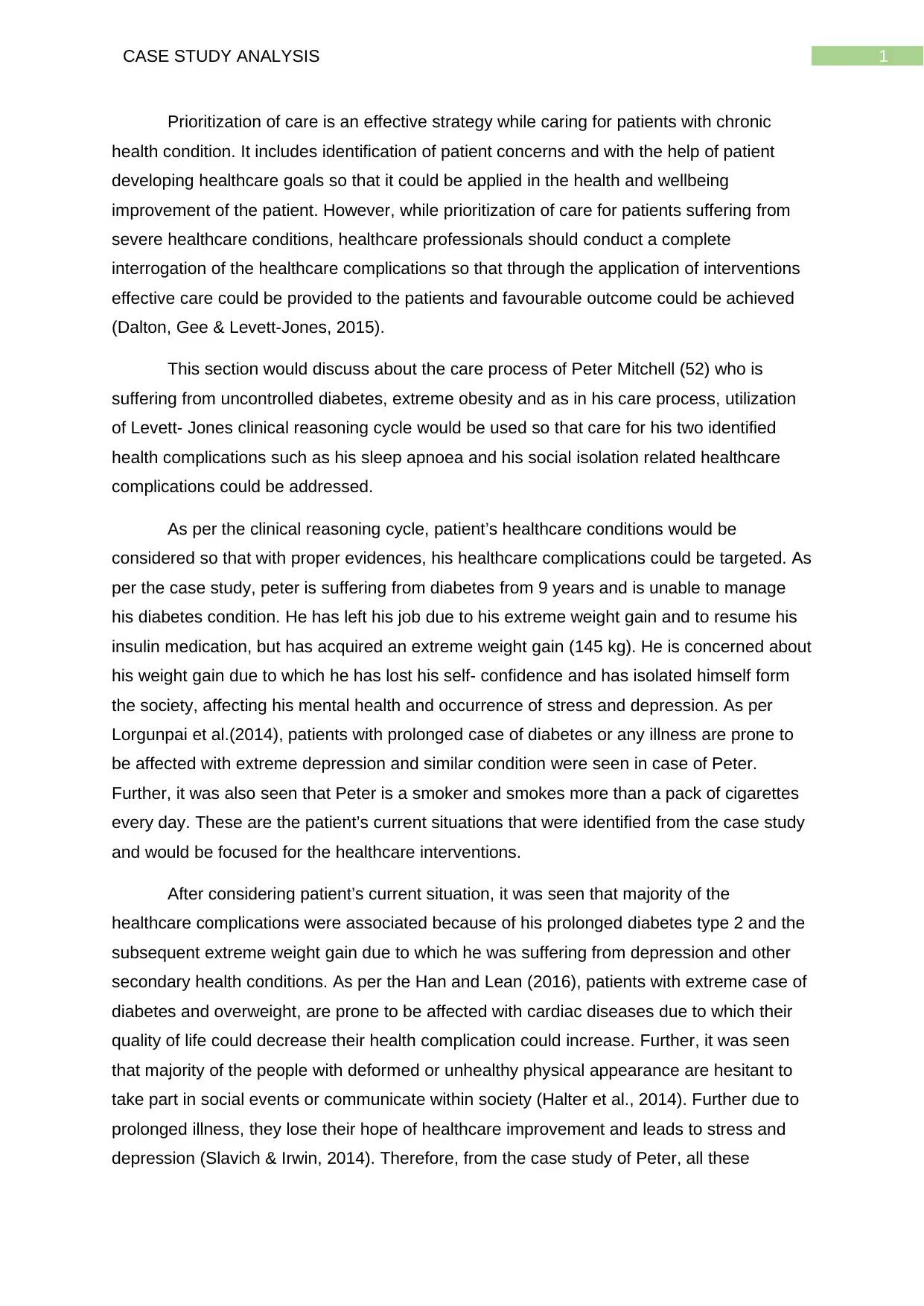
1CASE STUDY ANALYSIS
Prioritization of care is an effective strategy while caring for patients with chronic
health condition. It includes identification of patient concerns and with the help of patient
developing healthcare goals so that it could be applied in the health and wellbeing
improvement of the patient. However, while prioritization of care for patients suffering from
severe healthcare conditions, healthcare professionals should conduct a complete
interrogation of the healthcare complications so that through the application of interventions
effective care could be provided to the patients and favourable outcome could be achieved
(Dalton, Gee & Levett-Jones, 2015).
This section would discuss about the care process of Peter Mitchell (52) who is
suffering from uncontrolled diabetes, extreme obesity and as in his care process, utilization
of Levett- Jones clinical reasoning cycle would be used so that care for his two identified
health complications such as his sleep apnoea and his social isolation related healthcare
complications could be addressed.
As per the clinical reasoning cycle, patient’s healthcare conditions would be
considered so that with proper evidences, his healthcare complications could be targeted. As
per the case study, peter is suffering from diabetes from 9 years and is unable to manage
his diabetes condition. He has left his job due to his extreme weight gain and to resume his
insulin medication, but has acquired an extreme weight gain (145 kg). He is concerned about
his weight gain due to which he has lost his self- confidence and has isolated himself form
the society, affecting his mental health and occurrence of stress and depression. As per
Lorgunpai et al.(2014), patients with prolonged case of diabetes or any illness are prone to
be affected with extreme depression and similar condition were seen in case of Peter.
Further, it was also seen that Peter is a smoker and smokes more than a pack of cigarettes
every day. These are the patient’s current situations that were identified from the case study
and would be focused for the healthcare interventions.
After considering patient’s current situation, it was seen that majority of the
healthcare complications were associated because of his prolonged diabetes type 2 and the
subsequent extreme weight gain due to which he was suffering from depression and other
secondary health conditions. As per the Han and Lean (2016), patients with extreme case of
diabetes and overweight, are prone to be affected with cardiac diseases due to which their
quality of life could decrease their health complication could increase. Further, it was seen
that majority of the people with deformed or unhealthy physical appearance are hesitant to
take part in social events or communicate within society (Halter et al., 2014). Further due to
prolonged illness, they lose their hope of healthcare improvement and leads to stress and
depression (Slavich & Irwin, 2014). Therefore, from the case study of Peter, all these
Prioritization of care is an effective strategy while caring for patients with chronic
health condition. It includes identification of patient concerns and with the help of patient
developing healthcare goals so that it could be applied in the health and wellbeing
improvement of the patient. However, while prioritization of care for patients suffering from
severe healthcare conditions, healthcare professionals should conduct a complete
interrogation of the healthcare complications so that through the application of interventions
effective care could be provided to the patients and favourable outcome could be achieved
(Dalton, Gee & Levett-Jones, 2015).
This section would discuss about the care process of Peter Mitchell (52) who is
suffering from uncontrolled diabetes, extreme obesity and as in his care process, utilization
of Levett- Jones clinical reasoning cycle would be used so that care for his two identified
health complications such as his sleep apnoea and his social isolation related healthcare
complications could be addressed.
As per the clinical reasoning cycle, patient’s healthcare conditions would be
considered so that with proper evidences, his healthcare complications could be targeted. As
per the case study, peter is suffering from diabetes from 9 years and is unable to manage
his diabetes condition. He has left his job due to his extreme weight gain and to resume his
insulin medication, but has acquired an extreme weight gain (145 kg). He is concerned about
his weight gain due to which he has lost his self- confidence and has isolated himself form
the society, affecting his mental health and occurrence of stress and depression. As per
Lorgunpai et al.(2014), patients with prolonged case of diabetes or any illness are prone to
be affected with extreme depression and similar condition were seen in case of Peter.
Further, it was also seen that Peter is a smoker and smokes more than a pack of cigarettes
every day. These are the patient’s current situations that were identified from the case study
and would be focused for the healthcare interventions.
After considering patient’s current situation, it was seen that majority of the
healthcare complications were associated because of his prolonged diabetes type 2 and the
subsequent extreme weight gain due to which he was suffering from depression and other
secondary health conditions. As per the Han and Lean (2016), patients with extreme case of
diabetes and overweight, are prone to be affected with cardiac diseases due to which their
quality of life could decrease their health complication could increase. Further, it was seen
that majority of the people with deformed or unhealthy physical appearance are hesitant to
take part in social events or communicate within society (Halter et al., 2014). Further due to
prolonged illness, they lose their hope of healthcare improvement and leads to stress and
depression (Slavich & Irwin, 2014). Therefore, from the case study of Peter, all these
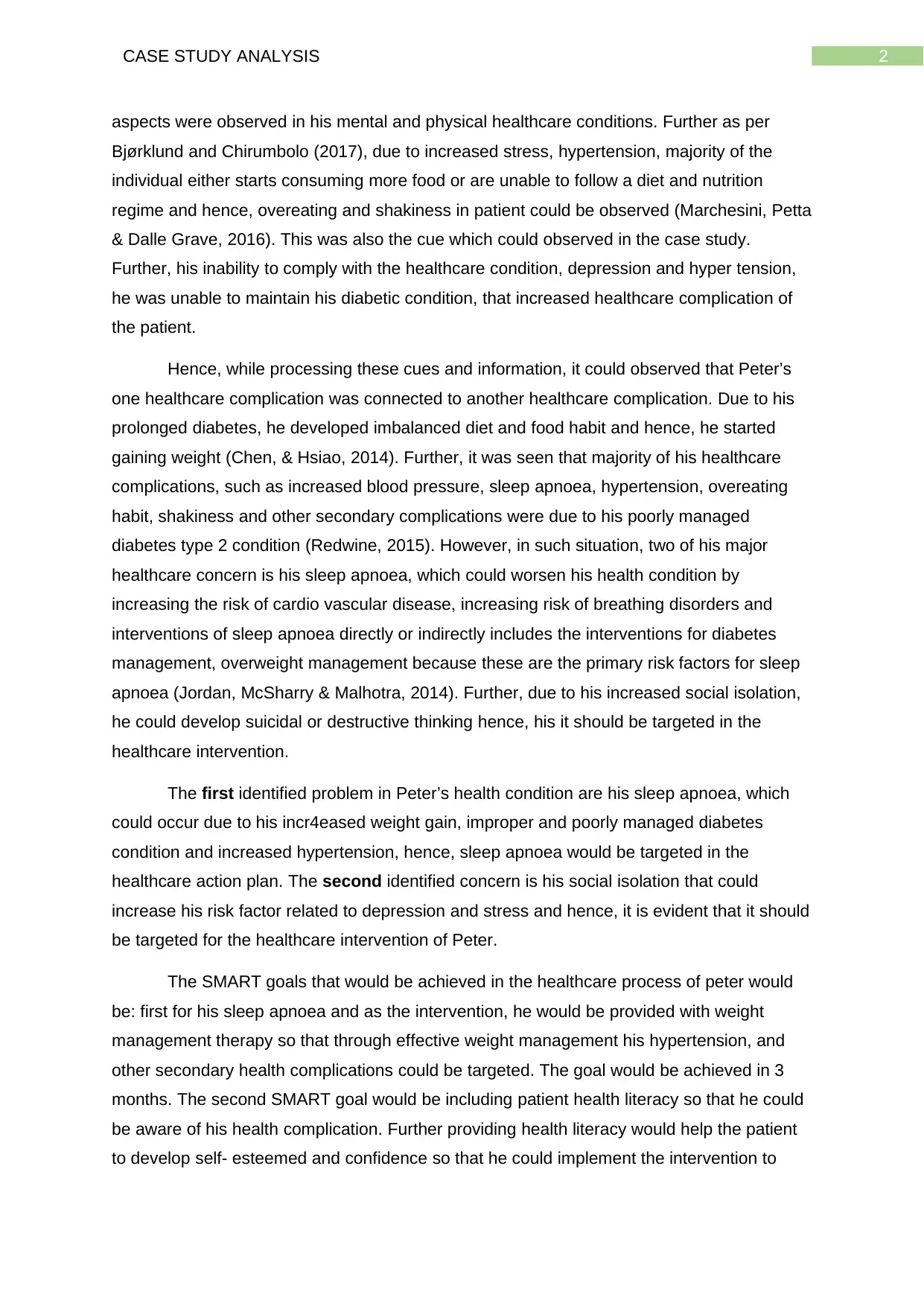
2CASE STUDY ANALYSIS
aspects were observed in his mental and physical healthcare conditions. Further as per
Bjørklund and Chirumbolo (2017), due to increased stress, hypertension, majority of the
individual either starts consuming more food or are unable to follow a diet and nutrition
regime and hence, overeating and shakiness in patient could be observed (Marchesini, Petta
& Dalle Grave, 2016). This was also the cue which could observed in the case study.
Further, his inability to comply with the healthcare condition, depression and hyper tension,
he was unable to maintain his diabetic condition, that increased healthcare complication of
the patient.
Hence, while processing these cues and information, it could observed that Peter’s
one healthcare complication was connected to another healthcare complication. Due to his
prolonged diabetes, he developed imbalanced diet and food habit and hence, he started
gaining weight (Chen, & Hsiao, 2014). Further, it was seen that majority of his healthcare
complications, such as increased blood pressure, sleep apnoea, hypertension, overeating
habit, shakiness and other secondary complications were due to his poorly managed
diabetes type 2 condition (Redwine, 2015). However, in such situation, two of his major
healthcare concern is his sleep apnoea, which could worsen his health condition by
increasing the risk of cardio vascular disease, increasing risk of breathing disorders and
interventions of sleep apnoea directly or indirectly includes the interventions for diabetes
management, overweight management because these are the primary risk factors for sleep
apnoea (Jordan, McSharry & Malhotra, 2014). Further, due to his increased social isolation,
he could develop suicidal or destructive thinking hence, his it should be targeted in the
healthcare intervention.
The first identified problem in Peter’s health condition are his sleep apnoea, which
could occur due to his incr4eased weight gain, improper and poorly managed diabetes
condition and increased hypertension, hence, sleep apnoea would be targeted in the
healthcare action plan. The second identified concern is his social isolation that could
increase his risk factor related to depression and stress and hence, it is evident that it should
be targeted for the healthcare intervention of Peter.
The SMART goals that would be achieved in the healthcare process of peter would
be: first for his sleep apnoea and as the intervention, he would be provided with weight
management therapy so that through effective weight management his hypertension, and
other secondary health complications could be targeted. The goal would be achieved in 3
months. The second SMART goal would be including patient health literacy so that he could
be aware of his health complication. Further providing health literacy would help the patient
to develop self- esteemed and confidence so that he could implement the intervention to
aspects were observed in his mental and physical healthcare conditions. Further as per
Bjørklund and Chirumbolo (2017), due to increased stress, hypertension, majority of the
individual either starts consuming more food or are unable to follow a diet and nutrition
regime and hence, overeating and shakiness in patient could be observed (Marchesini, Petta
& Dalle Grave, 2016). This was also the cue which could observed in the case study.
Further, his inability to comply with the healthcare condition, depression and hyper tension,
he was unable to maintain his diabetic condition, that increased healthcare complication of
the patient.
Hence, while processing these cues and information, it could observed that Peter’s
one healthcare complication was connected to another healthcare complication. Due to his
prolonged diabetes, he developed imbalanced diet and food habit and hence, he started
gaining weight (Chen, & Hsiao, 2014). Further, it was seen that majority of his healthcare
complications, such as increased blood pressure, sleep apnoea, hypertension, overeating
habit, shakiness and other secondary complications were due to his poorly managed
diabetes type 2 condition (Redwine, 2015). However, in such situation, two of his major
healthcare concern is his sleep apnoea, which could worsen his health condition by
increasing the risk of cardio vascular disease, increasing risk of breathing disorders and
interventions of sleep apnoea directly or indirectly includes the interventions for diabetes
management, overweight management because these are the primary risk factors for sleep
apnoea (Jordan, McSharry & Malhotra, 2014). Further, due to his increased social isolation,
he could develop suicidal or destructive thinking hence, his it should be targeted in the
healthcare intervention.
The first identified problem in Peter’s health condition are his sleep apnoea, which
could occur due to his incr4eased weight gain, improper and poorly managed diabetes
condition and increased hypertension, hence, sleep apnoea would be targeted in the
healthcare action plan. The second identified concern is his social isolation that could
increase his risk factor related to depression and stress and hence, it is evident that it should
be targeted for the healthcare intervention of Peter.
The SMART goals that would be achieved in the healthcare process of peter would
be: first for his sleep apnoea and as the intervention, he would be provided with weight
management therapy so that through effective weight management his hypertension, and
other secondary health complications could be targeted. The goal would be achieved in 3
months. The second SMART goal would be including patient health literacy so that he could
be aware of his health complication. Further providing health literacy would help the patient
to develop self- esteemed and confidence so that he could implement the intervention to
⊘ This is a preview!⊘
Do you want full access?
Subscribe today to unlock all pages.

Trusted by 1+ million students worldwide
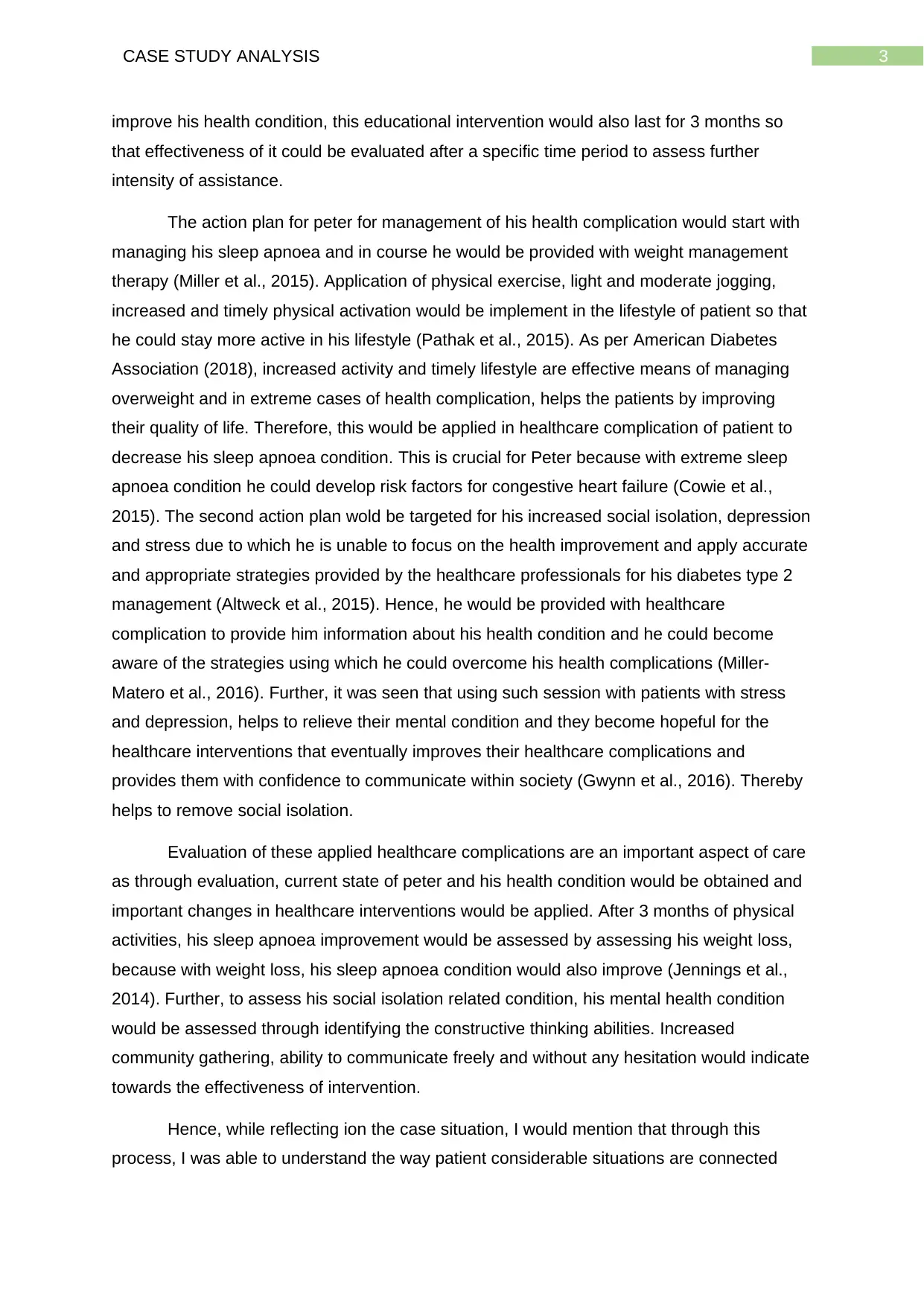
3CASE STUDY ANALYSIS
improve his health condition, this educational intervention would also last for 3 months so
that effectiveness of it could be evaluated after a specific time period to assess further
intensity of assistance.
The action plan for peter for management of his health complication would start with
managing his sleep apnoea and in course he would be provided with weight management
therapy (Miller et al., 2015). Application of physical exercise, light and moderate jogging,
increased and timely physical activation would be implement in the lifestyle of patient so that
he could stay more active in his lifestyle (Pathak et al., 2015). As per American Diabetes
Association (2018), increased activity and timely lifestyle are effective means of managing
overweight and in extreme cases of health complication, helps the patients by improving
their quality of life. Therefore, this would be applied in healthcare complication of patient to
decrease his sleep apnoea condition. This is crucial for Peter because with extreme sleep
apnoea condition he could develop risk factors for congestive heart failure (Cowie et al.,
2015). The second action plan wold be targeted for his increased social isolation, depression
and stress due to which he is unable to focus on the health improvement and apply accurate
and appropriate strategies provided by the healthcare professionals for his diabetes type 2
management (Altweck et al., 2015). Hence, he would be provided with healthcare
complication to provide him information about his health condition and he could become
aware of the strategies using which he could overcome his health complications (Miller-
Matero et al., 2016). Further, it was seen that using such session with patients with stress
and depression, helps to relieve their mental condition and they become hopeful for the
healthcare interventions that eventually improves their healthcare complications and
provides them with confidence to communicate within society (Gwynn et al., 2016). Thereby
helps to remove social isolation.
Evaluation of these applied healthcare complications are an important aspect of care
as through evaluation, current state of peter and his health condition would be obtained and
important changes in healthcare interventions would be applied. After 3 months of physical
activities, his sleep apnoea improvement would be assessed by assessing his weight loss,
because with weight loss, his sleep apnoea condition would also improve (Jennings et al.,
2014). Further, to assess his social isolation related condition, his mental health condition
would be assessed through identifying the constructive thinking abilities. Increased
community gathering, ability to communicate freely and without any hesitation would indicate
towards the effectiveness of intervention.
Hence, while reflecting ion the case situation, I would mention that through this
process, I was able to understand the way patient considerable situations are connected
improve his health condition, this educational intervention would also last for 3 months so
that effectiveness of it could be evaluated after a specific time period to assess further
intensity of assistance.
The action plan for peter for management of his health complication would start with
managing his sleep apnoea and in course he would be provided with weight management
therapy (Miller et al., 2015). Application of physical exercise, light and moderate jogging,
increased and timely physical activation would be implement in the lifestyle of patient so that
he could stay more active in his lifestyle (Pathak et al., 2015). As per American Diabetes
Association (2018), increased activity and timely lifestyle are effective means of managing
overweight and in extreme cases of health complication, helps the patients by improving
their quality of life. Therefore, this would be applied in healthcare complication of patient to
decrease his sleep apnoea condition. This is crucial for Peter because with extreme sleep
apnoea condition he could develop risk factors for congestive heart failure (Cowie et al.,
2015). The second action plan wold be targeted for his increased social isolation, depression
and stress due to which he is unable to focus on the health improvement and apply accurate
and appropriate strategies provided by the healthcare professionals for his diabetes type 2
management (Altweck et al., 2015). Hence, he would be provided with healthcare
complication to provide him information about his health condition and he could become
aware of the strategies using which he could overcome his health complications (Miller-
Matero et al., 2016). Further, it was seen that using such session with patients with stress
and depression, helps to relieve their mental condition and they become hopeful for the
healthcare interventions that eventually improves their healthcare complications and
provides them with confidence to communicate within society (Gwynn et al., 2016). Thereby
helps to remove social isolation.
Evaluation of these applied healthcare complications are an important aspect of care
as through evaluation, current state of peter and his health condition would be obtained and
important changes in healthcare interventions would be applied. After 3 months of physical
activities, his sleep apnoea improvement would be assessed by assessing his weight loss,
because with weight loss, his sleep apnoea condition would also improve (Jennings et al.,
2014). Further, to assess his social isolation related condition, his mental health condition
would be assessed through identifying the constructive thinking abilities. Increased
community gathering, ability to communicate freely and without any hesitation would indicate
towards the effectiveness of intervention.
Hence, while reflecting ion the case situation, I would mention that through this
process, I was able to understand the way patient considerable situations are connected
Paraphrase This Document
Need a fresh take? Get an instant paraphrase of this document with our AI Paraphraser
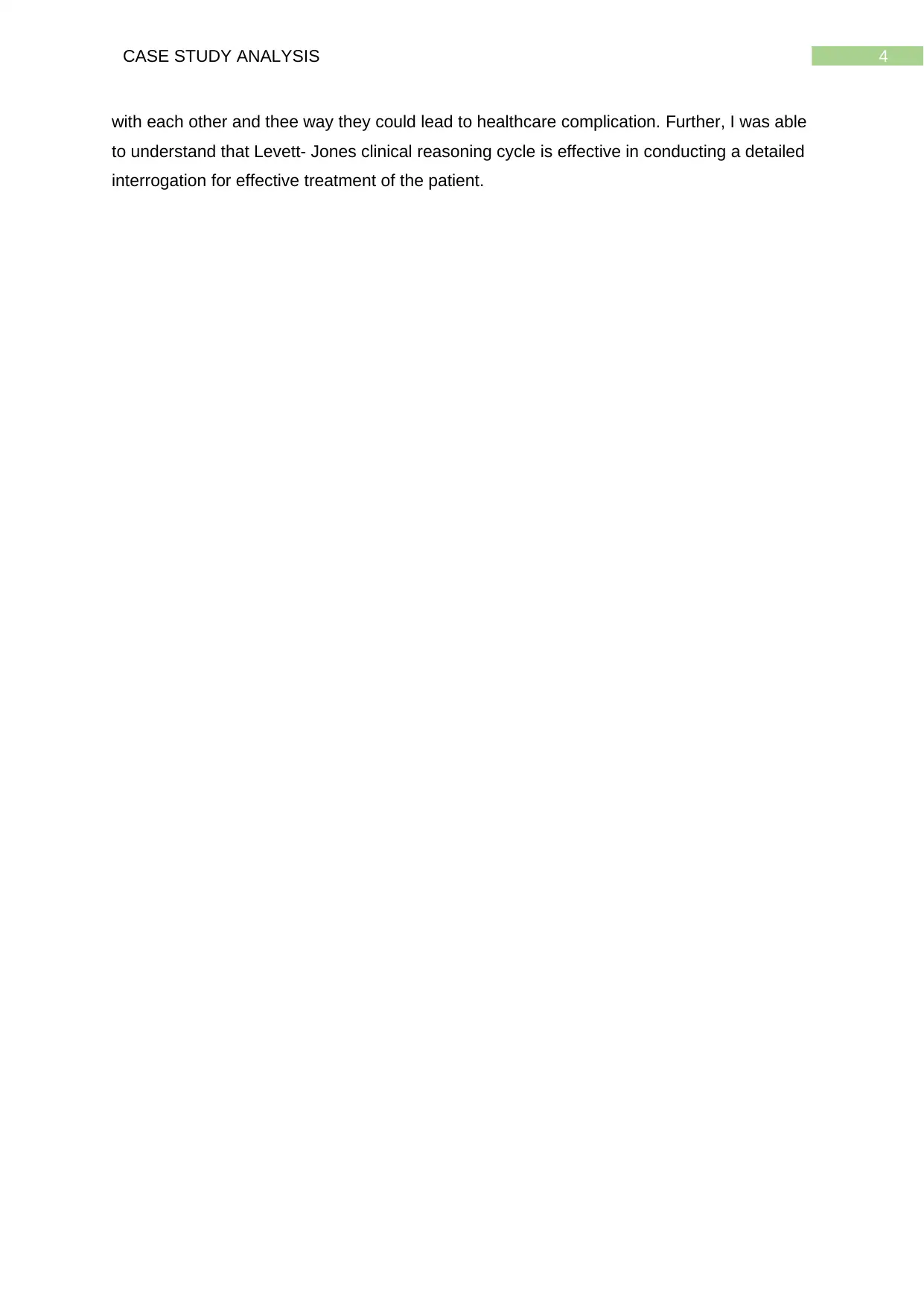
4CASE STUDY ANALYSIS
with each other and thee way they could lead to healthcare complication. Further, I was able
to understand that Levett- Jones clinical reasoning cycle is effective in conducting a detailed
interrogation for effective treatment of the patient.
with each other and thee way they could lead to healthcare complication. Further, I was able
to understand that Levett- Jones clinical reasoning cycle is effective in conducting a detailed
interrogation for effective treatment of the patient.
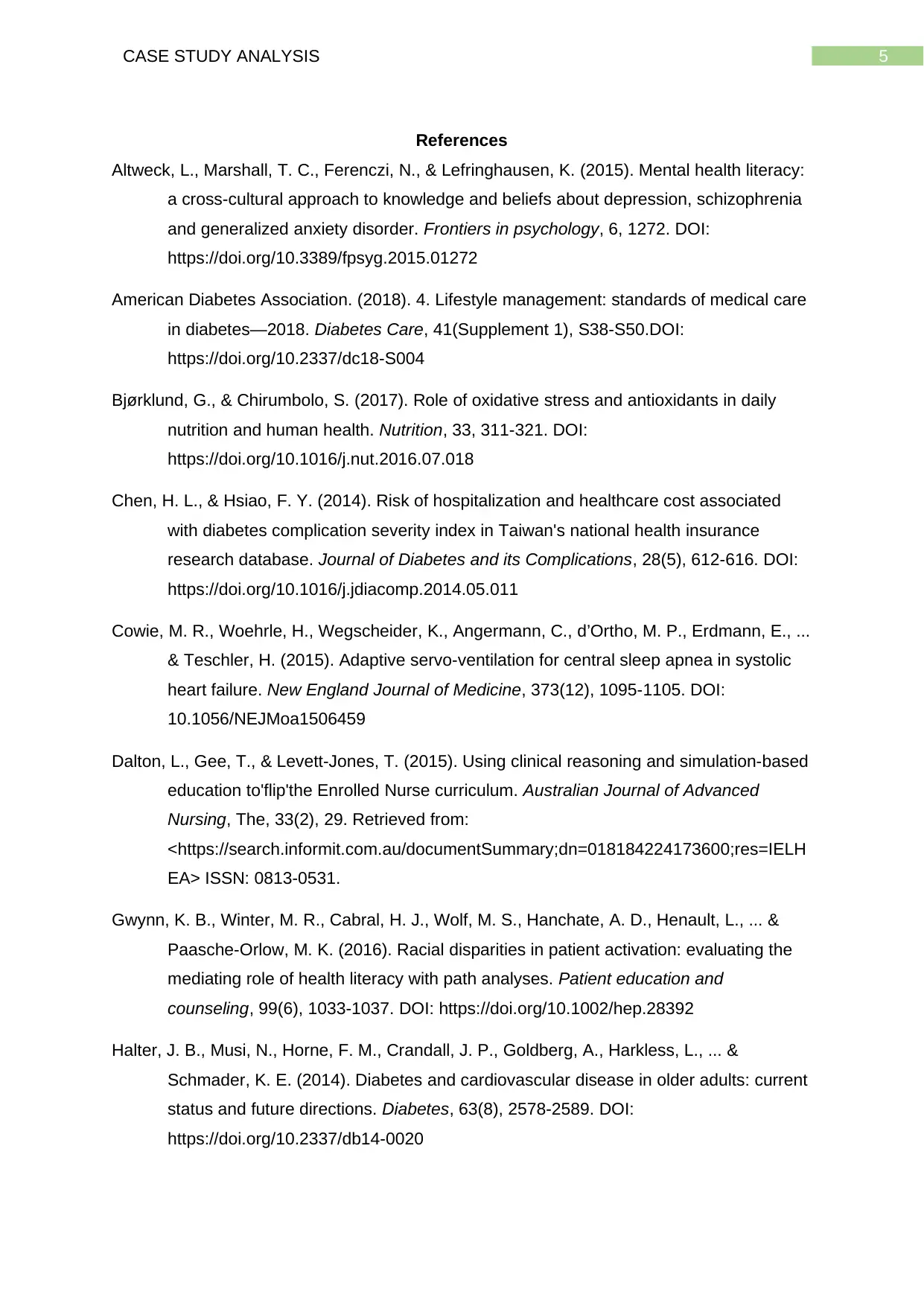
5CASE STUDY ANALYSIS
References
Altweck, L., Marshall, T. C., Ferenczi, N., & Lefringhausen, K. (2015). Mental health literacy:
a cross-cultural approach to knowledge and beliefs about depression, schizophrenia
and generalized anxiety disorder. Frontiers in psychology, 6, 1272. DOI:
https://doi.org/10.3389/fpsyg.2015.01272
American Diabetes Association. (2018). 4. Lifestyle management: standards of medical care
in diabetes—2018. Diabetes Care, 41(Supplement 1), S38-S50.DOI:
https://doi.org/10.2337/dc18-S004
Bjørklund, G., & Chirumbolo, S. (2017). Role of oxidative stress and antioxidants in daily
nutrition and human health. Nutrition, 33, 311-321. DOI:
https://doi.org/10.1016/j.nut.2016.07.018
Chen, H. L., & Hsiao, F. Y. (2014). Risk of hospitalization and healthcare cost associated
with diabetes complication severity index in Taiwan's national health insurance
research database. Journal of Diabetes and its Complications, 28(5), 612-616. DOI:
https://doi.org/10.1016/j.jdiacomp.2014.05.011
Cowie, M. R., Woehrle, H., Wegscheider, K., Angermann, C., d’Ortho, M. P., Erdmann, E., ...
& Teschler, H. (2015). Adaptive servo-ventilation for central sleep apnea in systolic
heart failure. New England Journal of Medicine, 373(12), 1095-1105. DOI:
10.1056/NEJMoa1506459
Dalton, L., Gee, T., & Levett-Jones, T. (2015). Using clinical reasoning and simulation-based
education to'flip'the Enrolled Nurse curriculum. Australian Journal of Advanced
Nursing, The, 33(2), 29. Retrieved from:
<https://search.informit.com.au/documentSummary;dn=018184224173600;res=IELH
EA> ISSN: 0813-0531.
Gwynn, K. B., Winter, M. R., Cabral, H. J., Wolf, M. S., Hanchate, A. D., Henault, L., ... &
Paasche-Orlow, M. K. (2016). Racial disparities in patient activation: evaluating the
mediating role of health literacy with path analyses. Patient education and
counseling, 99(6), 1033-1037. DOI: https://doi.org/10.1002/hep.28392
Halter, J. B., Musi, N., Horne, F. M., Crandall, J. P., Goldberg, A., Harkless, L., ... &
Schmader, K. E. (2014). Diabetes and cardiovascular disease in older adults: current
status and future directions. Diabetes, 63(8), 2578-2589. DOI:
https://doi.org/10.2337/db14-0020
References
Altweck, L., Marshall, T. C., Ferenczi, N., & Lefringhausen, K. (2015). Mental health literacy:
a cross-cultural approach to knowledge and beliefs about depression, schizophrenia
and generalized anxiety disorder. Frontiers in psychology, 6, 1272. DOI:
https://doi.org/10.3389/fpsyg.2015.01272
American Diabetes Association. (2018). 4. Lifestyle management: standards of medical care
in diabetes—2018. Diabetes Care, 41(Supplement 1), S38-S50.DOI:
https://doi.org/10.2337/dc18-S004
Bjørklund, G., & Chirumbolo, S. (2017). Role of oxidative stress and antioxidants in daily
nutrition and human health. Nutrition, 33, 311-321. DOI:
https://doi.org/10.1016/j.nut.2016.07.018
Chen, H. L., & Hsiao, F. Y. (2014). Risk of hospitalization and healthcare cost associated
with diabetes complication severity index in Taiwan's national health insurance
research database. Journal of Diabetes and its Complications, 28(5), 612-616. DOI:
https://doi.org/10.1016/j.jdiacomp.2014.05.011
Cowie, M. R., Woehrle, H., Wegscheider, K., Angermann, C., d’Ortho, M. P., Erdmann, E., ...
& Teschler, H. (2015). Adaptive servo-ventilation for central sleep apnea in systolic
heart failure. New England Journal of Medicine, 373(12), 1095-1105. DOI:
10.1056/NEJMoa1506459
Dalton, L., Gee, T., & Levett-Jones, T. (2015). Using clinical reasoning and simulation-based
education to'flip'the Enrolled Nurse curriculum. Australian Journal of Advanced
Nursing, The, 33(2), 29. Retrieved from:
<https://search.informit.com.au/documentSummary;dn=018184224173600;res=IELH
EA> ISSN: 0813-0531.
Gwynn, K. B., Winter, M. R., Cabral, H. J., Wolf, M. S., Hanchate, A. D., Henault, L., ... &
Paasche-Orlow, M. K. (2016). Racial disparities in patient activation: evaluating the
mediating role of health literacy with path analyses. Patient education and
counseling, 99(6), 1033-1037. DOI: https://doi.org/10.1002/hep.28392
Halter, J. B., Musi, N., Horne, F. M., Crandall, J. P., Goldberg, A., Harkless, L., ... &
Schmader, K. E. (2014). Diabetes and cardiovascular disease in older adults: current
status and future directions. Diabetes, 63(8), 2578-2589. DOI:
https://doi.org/10.2337/db14-0020
⊘ This is a preview!⊘
Do you want full access?
Subscribe today to unlock all pages.

Trusted by 1+ million students worldwide
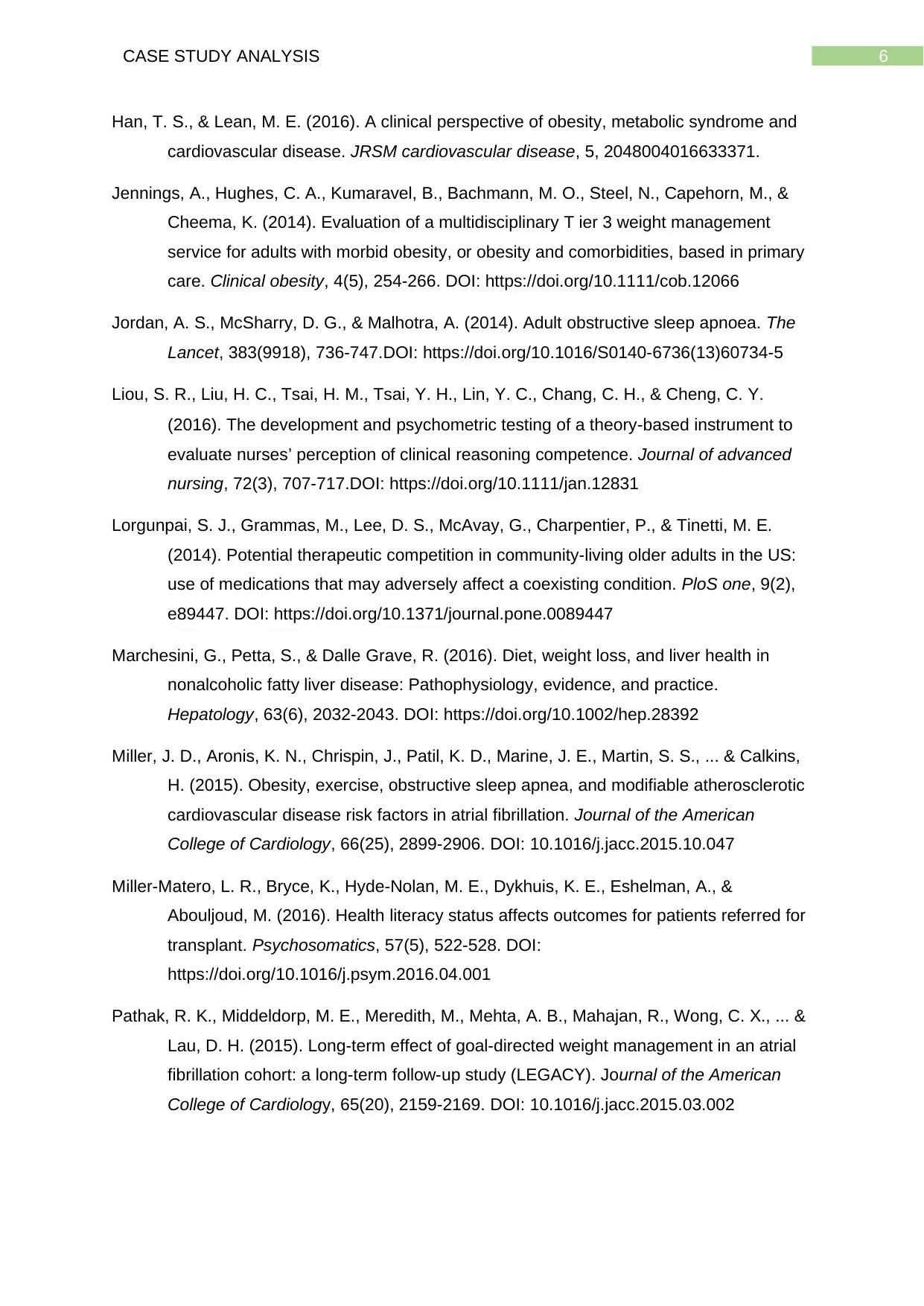
6CASE STUDY ANALYSIS
Han, T. S., & Lean, M. E. (2016). A clinical perspective of obesity, metabolic syndrome and
cardiovascular disease. JRSM cardiovascular disease, 5, 2048004016633371.
Jennings, A., Hughes, C. A., Kumaravel, B., Bachmann, M. O., Steel, N., Capehorn, M., &
Cheema, K. (2014). Evaluation of a multidisciplinary T ier 3 weight management
service for adults with morbid obesity, or obesity and comorbidities, based in primary
care. Clinical obesity, 4(5), 254-266. DOI: https://doi.org/10.1111/cob.12066
Jordan, A. S., McSharry, D. G., & Malhotra, A. (2014). Adult obstructive sleep apnoea. The
Lancet, 383(9918), 736-747.DOI: https://doi.org/10.1016/S0140-6736(13)60734-5
Liou, S. R., Liu, H. C., Tsai, H. M., Tsai, Y. H., Lin, Y. C., Chang, C. H., & Cheng, C. Y.
(2016). The development and psychometric testing of a theory‐based instrument to
evaluate nurses’ perception of clinical reasoning competence. Journal of advanced
nursing, 72(3), 707-717.DOI: https://doi.org/10.1111/jan.12831
Lorgunpai, S. J., Grammas, M., Lee, D. S., McAvay, G., Charpentier, P., & Tinetti, M. E.
(2014). Potential therapeutic competition in community-living older adults in the US:
use of medications that may adversely affect a coexisting condition. PloS one, 9(2),
e89447. DOI: https://doi.org/10.1371/journal.pone.0089447
Marchesini, G., Petta, S., & Dalle Grave, R. (2016). Diet, weight loss, and liver health in
nonalcoholic fatty liver disease: Pathophysiology, evidence, and practice.
Hepatology, 63(6), 2032-2043. DOI: https://doi.org/10.1002/hep.28392
Miller, J. D., Aronis, K. N., Chrispin, J., Patil, K. D., Marine, J. E., Martin, S. S., ... & Calkins,
H. (2015). Obesity, exercise, obstructive sleep apnea, and modifiable atherosclerotic
cardiovascular disease risk factors in atrial fibrillation. Journal of the American
College of Cardiology, 66(25), 2899-2906. DOI: 10.1016/j.jacc.2015.10.047
Miller-Matero, L. R., Bryce, K., Hyde-Nolan, M. E., Dykhuis, K. E., Eshelman, A., &
Abouljoud, M. (2016). Health literacy status affects outcomes for patients referred for
transplant. Psychosomatics, 57(5), 522-528. DOI:
https://doi.org/10.1016/j.psym.2016.04.001
Pathak, R. K., Middeldorp, M. E., Meredith, M., Mehta, A. B., Mahajan, R., Wong, C. X., ... &
Lau, D. H. (2015). Long-term effect of goal-directed weight management in an atrial
fibrillation cohort: a long-term follow-up study (LEGACY). Journal of the American
College of Cardiology, 65(20), 2159-2169. DOI: 10.1016/j.jacc.2015.03.002
Han, T. S., & Lean, M. E. (2016). A clinical perspective of obesity, metabolic syndrome and
cardiovascular disease. JRSM cardiovascular disease, 5, 2048004016633371.
Jennings, A., Hughes, C. A., Kumaravel, B., Bachmann, M. O., Steel, N., Capehorn, M., &
Cheema, K. (2014). Evaluation of a multidisciplinary T ier 3 weight management
service for adults with morbid obesity, or obesity and comorbidities, based in primary
care. Clinical obesity, 4(5), 254-266. DOI: https://doi.org/10.1111/cob.12066
Jordan, A. S., McSharry, D. G., & Malhotra, A. (2014). Adult obstructive sleep apnoea. The
Lancet, 383(9918), 736-747.DOI: https://doi.org/10.1016/S0140-6736(13)60734-5
Liou, S. R., Liu, H. C., Tsai, H. M., Tsai, Y. H., Lin, Y. C., Chang, C. H., & Cheng, C. Y.
(2016). The development and psychometric testing of a theory‐based instrument to
evaluate nurses’ perception of clinical reasoning competence. Journal of advanced
nursing, 72(3), 707-717.DOI: https://doi.org/10.1111/jan.12831
Lorgunpai, S. J., Grammas, M., Lee, D. S., McAvay, G., Charpentier, P., & Tinetti, M. E.
(2014). Potential therapeutic competition in community-living older adults in the US:
use of medications that may adversely affect a coexisting condition. PloS one, 9(2),
e89447. DOI: https://doi.org/10.1371/journal.pone.0089447
Marchesini, G., Petta, S., & Dalle Grave, R. (2016). Diet, weight loss, and liver health in
nonalcoholic fatty liver disease: Pathophysiology, evidence, and practice.
Hepatology, 63(6), 2032-2043. DOI: https://doi.org/10.1002/hep.28392
Miller, J. D., Aronis, K. N., Chrispin, J., Patil, K. D., Marine, J. E., Martin, S. S., ... & Calkins,
H. (2015). Obesity, exercise, obstructive sleep apnea, and modifiable atherosclerotic
cardiovascular disease risk factors in atrial fibrillation. Journal of the American
College of Cardiology, 66(25), 2899-2906. DOI: 10.1016/j.jacc.2015.10.047
Miller-Matero, L. R., Bryce, K., Hyde-Nolan, M. E., Dykhuis, K. E., Eshelman, A., &
Abouljoud, M. (2016). Health literacy status affects outcomes for patients referred for
transplant. Psychosomatics, 57(5), 522-528. DOI:
https://doi.org/10.1016/j.psym.2016.04.001
Pathak, R. K., Middeldorp, M. E., Meredith, M., Mehta, A. B., Mahajan, R., Wong, C. X., ... &
Lau, D. H. (2015). Long-term effect of goal-directed weight management in an atrial
fibrillation cohort: a long-term follow-up study (LEGACY). Journal of the American
College of Cardiology, 65(20), 2159-2169. DOI: 10.1016/j.jacc.2015.03.002
Paraphrase This Document
Need a fresh take? Get an instant paraphrase of this document with our AI Paraphraser
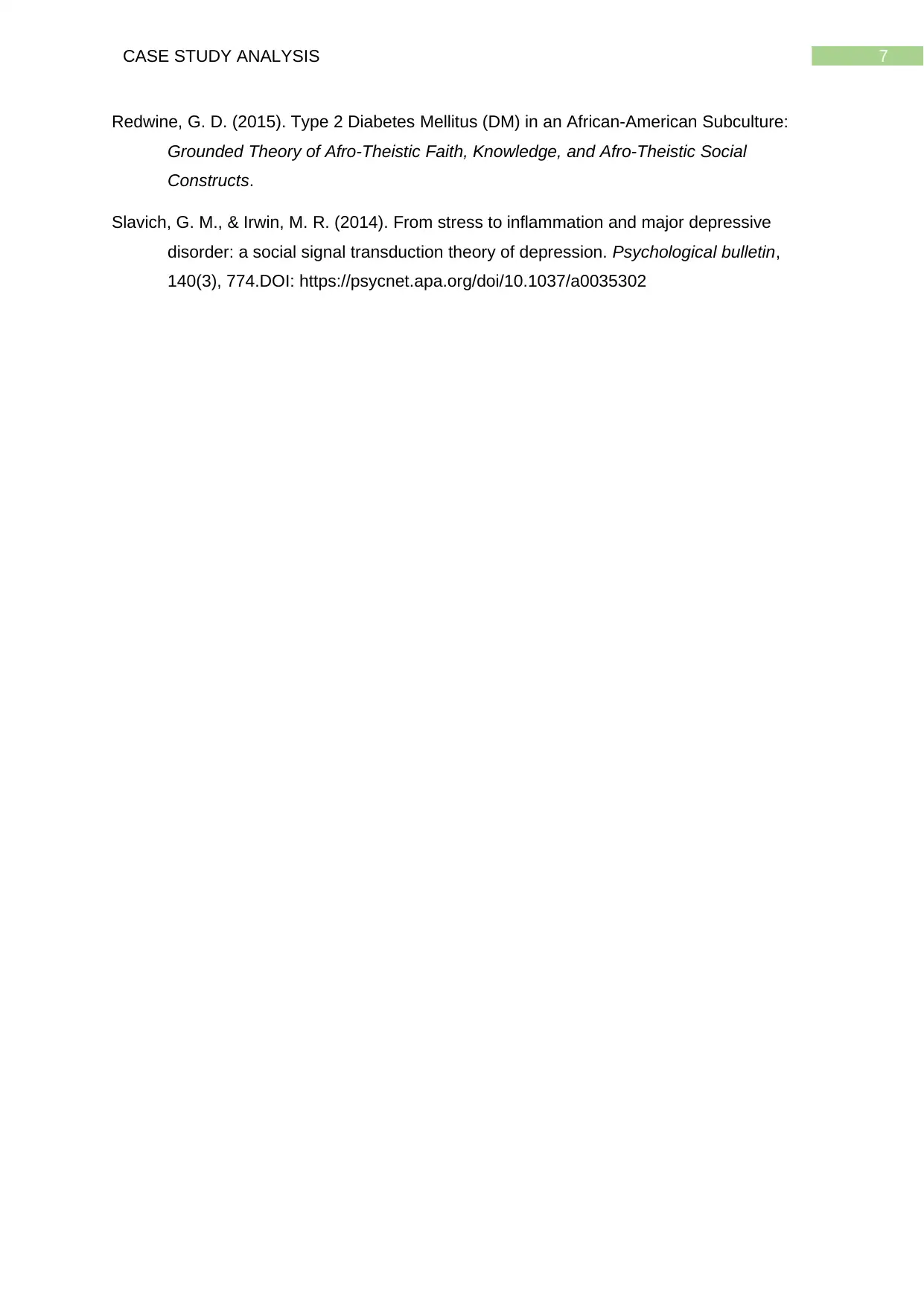
7CASE STUDY ANALYSIS
Redwine, G. D. (2015). Type 2 Diabetes Mellitus (DM) in an African-American Subculture:
Grounded Theory of Afro-Theistic Faith, Knowledge, and Afro-Theistic Social
Constructs.
Slavich, G. M., & Irwin, M. R. (2014). From stress to inflammation and major depressive
disorder: a social signal transduction theory of depression. Psychological bulletin,
140(3), 774.DOI: https://psycnet.apa.org/doi/10.1037/a0035302
Redwine, G. D. (2015). Type 2 Diabetes Mellitus (DM) in an African-American Subculture:
Grounded Theory of Afro-Theistic Faith, Knowledge, and Afro-Theistic Social
Constructs.
Slavich, G. M., & Irwin, M. R. (2014). From stress to inflammation and major depressive
disorder: a social signal transduction theory of depression. Psychological bulletin,
140(3), 774.DOI: https://psycnet.apa.org/doi/10.1037/a0035302
1 out of 8
Related Documents
Your All-in-One AI-Powered Toolkit for Academic Success.
+13062052269
info@desklib.com
Available 24*7 on WhatsApp / Email
![[object Object]](/_next/static/media/star-bottom.7253800d.svg)
Unlock your academic potential
Copyright © 2020–2025 A2Z Services. All Rights Reserved. Developed and managed by ZUCOL.





